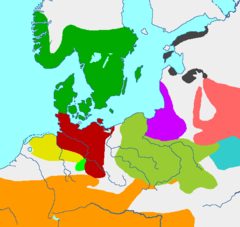Harpstedt-Nienburger Group

The Harpstedt-Nienburger group are some Iron Age archaeological finds from the North West German Geest belt between Ems and lower Mittelelbe associated with a focus on the Mittelweser . The name comes from the first place where pottery of the Nienburg type was found in Nienburg - Erichshagen , where the first finds were made in a burial mound field in the 19th century . The Harpstedt-Nienburg group occupied a middle position between the - in the Latène period, Celtic - southern Central Europe and the Jastorf culture, which stretched northeast between the Weser and the Oder estuary . In the south there were already features of a high culture with city-like settlements (so-called oppida ) with a rich upper class and intensive contacts with the Mediterranean region. In contrast, the Harpstedt-Nienburger Group shows only few changes compared to the Bronze Age, rather meager material conditions, only minor signs of social differentiation, and is regarded as an early stage of Germanic culture.
description
The finds of the Harpstedt-Nienburger Group are not uniform in terms of space and time. Because of the regional differences, a distinction is also made between an Ems-Hunte group in the west and a Nienburg group in the east. The difference between the house shapes is outstanding: in the western area, two-aisled houses were common, in the east and further north the three-aisled nave , which centuries later was further developed into a specialist hall house . In two-aisled and three-aisled houses people and animals lived under one roof ( residential stable house ). The simple farmsteads were scattered across the country as scattered settlements, a settlement structure that has been preserved west of the Weser to the present day.
The development over time concerns on the one hand the minor influences from the south in the Hallstatt period and stronger in the Latène period. In the 3rd century BC, ramparts were built again on the southern edge of the Harpstedt-Nienburger group.
On the other hand, the cult of the dead changed. The dead were commonly cremated throughout the culture. In the early and older Iron Age, the ashes were kept in urns and these were buried in grave fields, which were already used for this purpose in the Bronze Age. Later, the dead were burned on a stake in other places and the place of the cremation was then covered with a burial mound. Iron Age burial mounds in this area are much smaller than in other regions.
Ceramics


At the Harpstedt-Nienburger Group, the ceramic shapes of the Nienburger type emerged. The Nienburger cup is the leading form, the typical shapes of which are wide-mouthed, smooth vessels with a short neck and ample decoration on the vessel shoulder. Another characteristic vessel type of the Harpstedt-Nienburger group is the Harpstedter Rauhtopf , which is named after a place of discovery in Harpstedt in the district of Oldenburg .
Archaeological sites
Archaeological sites of ceramics from the Nienburger Group are:
- Erichshagen near Nienburg in a burial mound field as the first place where the Nienburg cup was found
- Wenden urn grave field, excavated around 1930 with around 130 burials
- Otersen , barrow field discovered around 1930 with 34 urns found
- Hohnhorst urn grave field , excavated urn grave field in 2011 with around 350 burials
- Iron Age settlement near Bantorf , settlement excavated in 2011
language
Proponents of the controversial Northwest Bloc theory assigned one or more of their own languages to the area of the Harpstedt-Nienburger Group, which was Germanized by a small Germanic upper class in the last century before the turn of the century. In contrast to the prevailing view, they assume a third Indo-European culture in northern Europe. It cannot be assigned to any other sublingual family, but there are Venetian- sounding place names in a small part of the area , so that a relationship to the Venetian is the least improbable connection.
See also
Web links
- Pre-Roman Iron Age in western Lower Saxony (PDF file; 475 kB)
- Grabhügelfeld in Erichshagen ( Memento from November 8, 2014 in the Internet Archive ) as the eponymous location of the Nienburger Group